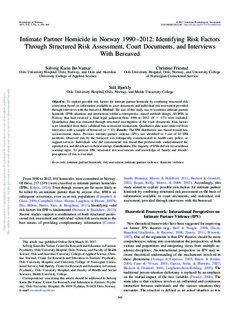| dc.contributor.author | Vatnar, Solveig Karin Bø | |
| dc.contributor.author | Friestad, Christine | |
| dc.contributor.author | Bjørkly, Stål | |
| dc.date.accessioned | 2018-12-04T10:38:23Z | |
| dc.date.available | 2018-12-04T10:38:23Z | |
| dc.date.created | 2017-03-28T09:38:11Z | |
| dc.date.issued | 2017 | |
| dc.identifier.citation | Psychology of Violence. 2017, 7 (3), 395-405. | |
| dc.identifier.issn | 2152-0828 | |
| dc.identifier.uri | http://hdl.handle.net/11250/2575941 | |
| dc.description.abstract | To explore possible risk factors for intimate partner homicide by combining structured risk assessment based on information available in court documents and individual risk assessment provided through interviews with the bereaved. Method: The aim of this study was to scrutinize intimate partner homicide (IPH) situations and interactions within a retrospective, mixed methods design. All IPHs in Norway that had received a final legal judgment from 1990 to 2012 (N = 177) were included. Quantitative data was extracted through structured investigation of the court documents. Risk factors were identified from three validated risk assessment instruments. Qualitative data were retrieved from interviews with a sample of bereaved (n = 12). Results: The IPH distribution was biased toward low socioeconomic status. Previous intimate partner violence (IPV) was identified in 7 out of 10 IPH incidents. Observed risk by the bereaved was infrequently communicated to health care, police, or support services. Individuals who did communicate risk found that professionals underestimated the reported risk and did not act on their warnings. Conclusions: The majority of IPHs did not occur without warning signs. To prevent IPH, structured risk assessments and knowledge of family and friends’ perceptions of risk is essential. Keywords: intimate partner homicide, risk assessment, intimate partner violence, domestic violence | |
| dc.language.iso | eng | |
| dc.title | Intimate partner homicide in Norway 1990–2012 : identifying risk factors through structured risk assessment, court documents, and interviews with bereaved | |
| dc.type | Peer reviewed | |
| dc.type | Journal article | |
| dc.description.version | publishedVersion | |
| dc.source.pagenumber | 395-405 | |
| dc.source.volume | 7 | |
| dc.source.journal | Psychology of Violence | |
| dc.source.issue | 3 | |
| dc.identifier.doi | 10.1037/vio0000100 | |
| dc.identifier.cristin | 1461577 | |
| cristin.ispublished | true | |
| cristin.fulltext | original | |
| cristin.qualitycode | 1 | |
